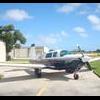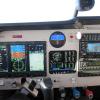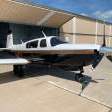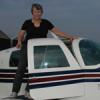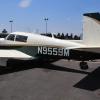Leaderboard
Popular Content
Showing content with the highest reputation on 12/10/2016 in all areas
-
That's funny. I have a GTN 750 and a GTN 650, a GDL 88, and a Flightstream 210. I use a Mini 4 in a yoke mount running ForeFlight. I have so much data, cross feeding, that the redundancy is ridiculous. My passengers can amuse themselves playing with an AERA 796 in an Airgizmo panel mount that also is coupled to the GTNs. (Also a MidContinent Life Saver back-up electric AI, and a back-up electric vacuum pump in the tail one). Sometimes I just have to laugh at myself, but then I remember that over the years I have lost vacuum pumps in IMC. In both instances the back-ups made the situation an annoyance, rather than a serious problem. With an Icarus Sam GPSS steering unit, and a KAP 150, using Flightstream and ForeFlight I have programmed 600 mile+ flights with multiple waypoints. And then at about 1500'. Coupled the autopilot to fly the route. I've mentioned it before, I almost always hand fly the return flight but I sure appreciate the new avionics. Sent from my iPhone using Tapatalk2 points
-
Regarding your poverty remark, just like Yogi Berra, my dad has come up with a few adages of his own over the decades. One of my favorite is "There is nothing inherently wrong with communism. It's just that everybody should be rich instead of poor.". In case you were wondering, my other favorite is "If a woman isn't pretty on her wedding day, then there's no hope for the rest of her life".2 points
-
finished tail pipe hanger tightening. replace panel. took way longer than that should have. cleaned panels. cleaned the trim wheel screw chain, who thought that grease could become so hard. Lubed everything in the tail section. Sucked some brake fluid through the right brakes. Aired up the tires. cleaned some things. Waiting on the gear actuator....2 points
-
Locking this down since it fell off topic into politics .2 points
-
Guys settle down please. This topic was started as an idealistic opportunity to improve the FAA from the top down not a political battle ground. We all like to fly and we all like to fly Mooney. I'd rather see arguments over LOP vs ROP (but not in this thread) at least that is aviation related. This is remotely related with it's connection to the FAA and regulations.2 points
-
After a fuel stop, I taxied my '64 C (manual gear) onto the active after my run-up. I was going maybe 3-4mph, and all of a sudden, the nose gear collapsed, followed by both mains about a second later. After the initial shock of what had just happened, I quickly hit the master switch off, shut off the fuel, and exited the aircraft. The J-bar never moved out of the block. Fortunately, there was an A&P on the field, along with a group of other very nice folks who helped me put the plane on jacks, and then onto a flatbed trailer. 3 hours after the collapse, we towed my Mooney into a hangar. We just recently got it back on jacks and off the trailer, and the inspection of what happened started. Backstory: My Mooney (most of you probably recognize it as N6XM, a fantastic example of a C model) underwent an Annual at a MSC in October. Since the annual, I have put roughly 10 hours, and only a handful of landings on it. This MSC (I'll keep their name out of it) treated me very well, and conducted a very detailed annual. Because 6XM was so well maintained before, they really didn't find much wrong with it. Among other things, they shimmed the nose gear steering assembly, and adjusted the preloads on all three landing gear. Before they adjusted any preloads, they said one of the mains required sufficient torque to break the overcenter joint, but the other main and nose were low. So they adjusted the retraction trusses accordingly and brought the other main to within spec, and the nose to about 125 in/lbs After the collapse, I called the MSC who offered to fly out and preform an inspection to determine what went wrong. One of the retraction trusses broke when the gear collapsed. I will include pictures later, but it broke in two places. Looking inside the truss that broke, there doesn't appear to be very much corrosion. Once side is clean and shiny, the other has just a few specs of brown in it. The walls of that tube may appear to be slightly thinner but it is hard to tell. The other truss bent during the collapse. The weld that connects the vertical portion of the J-bar to the block on the bottom tore like a piece of paper. An additional weld separated (not completely) on point that the J-bar attaches to the retraction truss that did not break. Unfortunately, this makes it impossible to do a preload check on the nose gear. The overcenter joint doesn't appear to have any play in it. So we don't know exactly what happened. The best that we could come up with is that the truss walls were thin due to aging. When they adjusted the truss, (even if it was to spec), that an enough stress on that tube to cause it to fail. Once that tube went, the overcenter joint could have broke center, and the nose gear went down. That pulled on the other retraction truss, which pulled on the J-bar causing it to tear, and allow the mains to come down. I have read that the aluminum block the top of J-bar seats in can wear, causing it to lock in place, but not as far forward as it is meant to be. This can limit the travel of the overcenter joint, and cause the gear to collapse. I need to inspect the block, and will post the results. For those of you who haven't read it, this is a MUST READ if you have a J-bar in your Mooney: http://www.knr-inc.com/shoptalk-articles/25-shoptalk/41-200305-manual-gear-mooneys So now I am waiting on a quote to see how much this will cost. Fortunately, the insurance company is willing to work with me. I know I can't find another Mooney this nice (at least not right now) for what I got 6XM. Pretty upset, as I have put a decent amount of money into 6XM since I've had it...but such is life. At least it happened with just me on board, I didn't get hurt, and it was only a 25 min drive from home. But if anyone has any other ideas on what happened, (or advice on a way forward) I'm all ears!1 point
-
I've started to hear and read about this stuff recently and now I read an FAA article with a list of airports this technology is available at. I like the idea of having a flight plan beamed to your cockpit and being able to press a button to upload that into the FMS. Seems like this will safe time and reduce the possibility of errors. The downside though is it reduces the need for a pilot just a little more. Doesn't eliminate it but we're a small step closer to a completely autonomous passenger carrying plane. Now the question remains, how long before this technology is made affordable for GA aircraft? FAA Data com article1 point
-
Just got my instrument rating this morning. I have had my ppl and the mooney for 3 years and I have really learned a lot from this forum that no doubt helped with the ir. I wanted to say thanks to everyone here for the advice. I will be making a donation to the site but keep in mind that most of my money lately has been going to the plane, gas and instructors. Thanks1 point
-
1 point
-
1 point
-
Bowel movement safety overide switch. Comes in handy on long flights. Does it by any chance also have long range tanks? They go together..,parts of same mod.1 point
-
1 point
-
Not worth it in my book - not until the vacuum canister is beyond repair and Britain doesn't come through with the replacement they've been talking about. Otherwise we'd be looking at $6K for new brakes plus installation cost for few days of labor. At least you can still pull your electric standby vacuum pump from the avionics bay and get some useful load back like I am doing; that's more significant than the weight of the engine vacuum point too. Sent from my iPhone using Tapatalk1 point
-
Buy it for $30, watch it, sell it for $20. Cost's you $10. Plus the popcorn. I recommend the Whirley Pop: http://www.whirleypopshop.com/1 point
-
1 point
-
OK new owner, raise your hand. Are you an MSer that we know? That is a beautiful Mooney you have There! Best regards, -a-1 point
-
Meanwhile, I've been at work since 0730, while the plant is shut down, with contractors finishing an installation that "won't take us but half an hour." At least the plane is plugged in, warmed up and ready to go--just not to SPA for breakfast . . .1 point
-
And this could also be done with a SDR/Raspberry PI and a 10 watt transmitter for about $100 and some programming.1 point
-
Not necessarily. It depends on how the data are sent to/from the plane and the level of required operational performance demanded of Data Comm, which is a part of FAA NextGen planning. A recent FAA document explains (?) Data Comm in this overview: Data link applications are being implemented in flight operations utilizing FANS-1/A (which includes CPDLC and Automatic Dependent Surveillance-Contract (ADS-C). Data link applications operate without any specific knowledge by the user as to whether a satellite, VHF, (VDL M0/A or VDL M2) or HF data link (HFDL) sub-network service is in use. However, these applications may be limited by the level of end-to-end data link service implementation in use (e.g., ACARS, FANS-1/A ARINC 622). The different systems include ATN-Baseline 1, a digital system and FANS-1A, which is basically an analog based system. At the present time the digital operation is known as VDL-Mode 2 system. The analog operation is known as the VDL-Mode 0/A. The FANS 1/A system uses both digital and analog components. SOURCE: FAA Document on Performance Based Flight Systems -- Data Comm As Part 91 operators we could use (say) UHF terrestrial links such as a GDL-88 UAT coupled to a GTN750. In that case the user-side hardware may be in place now. (it is in my plane, for example) Firmware enhancements to those boxes could enable ADS-C transceiver operation within the UAT, the processor and display of the GTN750 could show the message and, if it the message is a flight plan, load it after pilot review into the active flight plan. If we were to use (again hypothetically) the VHF data link capability in the current communications band 118-136 MHz then a low-data-rate (on the order of 50 kbps) link can be enabled via (again) firmware upgrades to a GTN750-like device with no other hardware changes. The hardware is the easier part. Key to any FAA technology program final approval are the four measures: reliability, accuracy, integrity, and availability. All are achievable with existing link technology. Any Data Comm system is likely to have a backup requirement, but that backup is in place now (the controller can read you the clearance via VHF AM radio and you as pilot can read it back, just like your grandfather did). None of this equipment will tax the payload of even an old Mooney. Cost and time to implement and gain FAA operational approval, well that's another matter. The airlines are using this now at the selected list of major airports. Perhaps a near-term question might be what Part 91 operators could do to make use of the Data Comm system for terminal clearance delivery at those airports? I can picture the system in use: I'm flying along, and the "MSG" flag appears on the G500 display. I push the soft key on the GTN750, it says, "New Flight Plan Upload, Review?" I press "PREVIEW" and see a graphic of the proposed new flight plan. If it is OK, I sigh and push "LOAD" and the new flight plan becomes active. Then I see an acknowledgement "ATC Receipt" flag. As the FAA states, it will be transparent (irrelevant) to the user how the message arrived -- VHF, UAT, or via satellite. That sounds way better than hearing the dreaded ATC phrase, "I have an amendment to your route" and getting ready to copy all sorts of unexpected gibberish. No more wondering, "did he say HOGGS or GROBS?"1 point
-
Hey, don't get me wrong, I have been trying to find a way to get a G5 in to do the exact same thing you have done. As an Aspen 2000 owner it makes no sense to me that with two AIs on the Aspens that a G5 can't be the backup to them. ESPECIALLY since they will let the G5 be a primary AI. I also realize as a long time owner that no two FSDOs are created the same. In NY I had a sub panel built and signed off, only to have the Philly FSDO say it had to be removed. The G5 does in fact use the airspeed and GPS input with the AHRS for attitude determination. But according to the manual, accuracy although affected, is still valid. I also know that some people have used the L-3 ESI-500 and the Sandra offerings as backup to the G500, so what you are saying is true. Everything is clear as mud. After getting the Aspen STC, I am now more concerned about whether the G5 or any other electronic AI can be used in a plane without two electrical systems. Keep us posted on the experience with the new hardware. Sent from my iPad using Tapatalk1 point
-
1 point
-
The LAST thing I saw when you walked into the classroom was a "wet behind the ears young punk." Then again, I was a 19 year old freshman!1 point
-
My thoughts exactly- Why couldn't the AME do the "discussion" instead of a full 3rd class as they would be a "state licensed physician"? Also, as Don mentioned- We don't even know hat the regs will be, yet- Cart before the horse syndrome right now.1 point
-
Later the same day, Sunday November 20, 2016, we took a second flight. We departed Nueva Gerona and flew straight to Havana. This was just a 45 minute flight and pretty straight forward. They had me do a STAR which took a little prep but wasn't much to it. An ILS approach had me land to some jets holding short. Taxied behind a 737 but pulled into the FBO they have for GA. Havana was the only airport with a separate General Aviation terminal. They were a bit more prepared to handle a small plane but everything still took forever. We had to show our passports to ten different people and wait and wait and wait at different stages of coming out of the airport. We spent all of the next day, Monday, in Havana and flew out Tuesday morning. There is plenty to see in Havana. The contrast between grandeur and poverty is quite striking. Nearly all of the grand buildings are from before the revolution. Poverty is pretty much everything else. I think the video of Havana below sums it up quite well. You can see a Cuban supermarket in the freeze frame below:1 point
-
Well it was neat to see both our very own Bennett and Seth featured in the owner feedback section.1 point
-
Your point is well taken, but I still endorse Todd Palin. Any guy who names his daughter after an aircraft manufacturer is OK in my book.1 point
-
Coincidentally(?) Don Maxwell just posted in the MAPA discussion group and encouraged spreading the info: "It seems as these Johnson bar gear ups go away for years, then the planes change hands, the old mechanic die and here we go again. In the last 10 days I have had calls on three J-bar gear ups. All three just out of annual. One was the failure of the J-bar itself. Pic 2198 is of the jbar still latched and all three gear went down. Pic 2196 is the bellcrank welded to the bottom of the J-bar. New J-bars have a strap welded around the bottom for added strength. Lasar has been doing this mod to J-bars they repair for many years. It looks as though there may have been corrosion in that area. Have your mechanic pay close attention to the weld area at the base of the J-Bar. The one thing I see and hear over the years are new mechanics fascinated with the J-bar system and want to adjust one. It is not that difficult but should be shown by someone with experience. If a J-bar, installed at the factory, is greased regularly I doubt it would be out of adjustment 40 years later. If a J-bar system is out of rig it’s because someone screwed with it. Be very careful about mechanics changing preloads if they are not experienced. Feel free to pass this on. Don Jason, I hope you already know that if you've put quite a bit of money in avionics, paint, interior, mods,... whatever and have not raised the hull coverage to reflect the increased value you might be at risk of having the insurance adjuster decide their best cost solution is to pay you the hull coverage and take the plane and all your goodies for salvage. Hope that doesn't apply in your case. A typical gear up (& required engine tear down) will run $30,000 +/-.1 point
-
1 point
-
Said the pot to the kettle! Let's keep it civilized, please.1 point
-
1 point
-
The 261 and the 262 are essentially the same conversion from a 231. From firewall forward the standard 252 engine and cowl was installed. A second alternator was normally fitted, along with a one piece belly pan then all sorts of speed mods and fairings were installed. Many added ram air for the magnetos to control missing. It was usual to remove the step, and move the comm antennas into the wing tips. Some of us added a third gear door to fully enclose the main gear, and added overlapping nose gear doors . But what gave it more speed in the higher 20s was a special McCauley "high altitude" two bladed prop. This prop has a different built in twist. These conversions with this prop were no faster than a 231, and maybe a bit slower, up to about 18,000', but then the prop was like another gear in a car. These props have a heated leading edge. Many/most of the 261/262s had long range tanks installed, and they were/are/ great traveling machines. Critical altitude was around 24,000', and they were very fast at FL270. I made many trips crossing the country, west to east, with just one fuel stop by flying high (FL270) in winter, catching the lower level of the jet stream. On one trip ATC verified a ground speed of 315 knots average over several hours. Cold and mushy controls, but the speed was worth it. The Trophy 261 vs the 262 was just marketing between Coy Jacobs, Mod Squad, and Tim Combs at the Mod Works,although at one point they were partners at the Mod Works, and some 261s, like mine, were built at the Mod Works. I think mine was the first of the 261s, and a brand new Continental engine was installed (and immediately ported and polished). She was a great aircraft, but way overkill for the weekend $100 hamburger run. Coy took his virtually identical 261 into the lower FL30s with a pressure oxygen system. Coy eventually bought mine (after I beat him on a cross country flight). The POH was just about identical to the 252, and the Service Ceiling was 28,000' Sent from my iPhone using Tapatalk1 point
-
I like the way you're thinking. I did very much the same with my first Mooney. If I think about what a Mooney is used for, I wanted a good long distance IFR machine. That meant a proper T panel config, an HSI, a WAAS GPS, and a good autopilot. I decided I wouldn't look at anything less. I also wanted an engine in the sweet spot between 500 hours and 1000 SMOH. Beyond that I had a wish list that included ADSB, Engine monitor, speed mods (the early birds really benefit from them), paint and interior. Ideally I wanted all of this in an E and had a $50K budget. All the really nice E's were between $60K and $70K and I really didn't want to compromise. So I found a C at $48K that was everything except the ADSB and Engine monitor. I bought it and flew 400 hours in 2 years with no maintenance issues over $1000. Along the way I added the ADSB and engine monitor. Now I fly a K 252. This time I didn't buy the most expensive K252 as the most expensive models I found seemed to have spend money in the wrong places and neglected the things that matter most. But I did buy a nice one. Most of us on this board would recommend that you buy at the high end of the range. Don't stretch to get into a cheap J, rather buy the top of the range E or even C. In the long run, you'll be much happier and will have made a better investment. BTW I sold my $48K C for $50K after two years.1 point
-
1 point
-
This seems like a lot about nothing. When you look at the details, all you would get is GPS track on the HSI page; which you already have at the top of the G5 display. Its not like G5 users are missing out on Heading info, which is only provided in the G5 experimental version if you have both the G3 and an optional magnetometer. And its still only a backup to the G3. So frankly, even if they didn't hide the HSI function on the certified version, wouldn't that be a waste of glass real estate to display the same GPS track info already displayed. But of course you got a great new glass certified primary attitude display with all the other nice features IAS, altitude, VSI etc is all great stuff - and it looks nice in your panel. You did good and got some excellent capability for half the cost of anything else and that's the real point of the matter! On the other hand if anyone really want the whole enchilada, certified to support navigation, synthetic vision, obstacles and even heading - that's available too, starting at couple more AMU's - the L3 ESI-500.1 point
-
Chris, you realize there's anal exam included in the new language...not sure that should be considered a favor1 point
-
Something I found that helps with memory is to talk out loud what you need to remember. When you read back a clearance it helps remembering it. Common sense thinking and experience helps you out in assessing new situations. A young pilot in an emergency may have to recall from what he learned but an old pilot recalls from actual experience. Remembering names are the hardest. But if you relate the name to an object it makes it easier to remember. Like Trump to an elephant or Clinton to clean-tooth. José1 point
-
I would be really surprised if it only took the A&P 30 minutes to round up the tire and tube, round up the tools, get to the plane or get the plane to him, change the tire and tube, and write up the log entry. $100 is very reasonable labor rate for this task, and seems even more so in $unny California. You are paying him for time spent in your benevolence, not just the time his hand touches a wrench.1 point
-
Saturday, November 18, 2016 was the 2nd day of the Cuba flying adventure. We came to the airport at Santiago de Cuba and were met with bureaucracy like I've never seen. They could not fathom the idea of someone boarding an airplane without a boarding pass so they wrote our names by hand onto blank ones. We had to go through security even though we were the only non-personnel at the entire airport. It took hours before we could depart. It took about 30 minutes to get a flight plan filed. I had to walk to the flight planning office. I had a printed copy that I had prepared from flightaware back home. They made me rewrite it onto their paper one by hand. Then the guy sat there entering it into the computer with one finger at a time. I was tempted to push him off the computer and type it in myself. When he couldn't understand my hand writing, he would look at my printed flight plan instead! Given that it gets typed into a computer, it's crazy that he couldn't just take mine in the first place. On the wall they had a chart of cuba with pins/strings denoting routes. The flight plan filer checked my route on his wall chart but was having trouble finding things so I just showed him on the ipad instead. The bureaucracy did not end here. Preparing the bill took the longest time. Unlike other Caribbean destinations where they pull a price out of their behind, they had every fee charted to the cent. Landing fee, ramp fee, security fee, departure fee, air traffic control fee, etc etc. Nobody prepares paperwork in advance. You just have to sit and wait for them to figure it all out. They made 6 copies of the bill and I had to sign each one. Cash is the only form of payment and it has to be in CUC. The exchange office was closed so it took a lot of negotiating to get them to finally agree to take dollars corrected for their inflated currency and that they would get it changed after the lunch break. We were finally able to depart. The flight was pretty straight forward. IFR departure, climb over the deck, one or two fixes and then direct. Took just a little over 2 hours. The clouds were breaking up near Trinidad so I requested the visual approach while monitoring the NDB approach via GPS. Trinidad airport was a huge relief. Just one or two people on staff, spoke English, no procedures to waste time on. Trinidad is a more rustic town. Colonial architecture and old cars go together. The town is littered with tourists. We visited a sugar plantation outside of town and walked to the adjacent village. Some scenes of rural Cuba and experiencing Trinidad (Cuba) in the video:1 point
-
From a guy who had similar starting issues (perhaps not quite as bad) I found two things that really helped. First, I had Champion massive spark plugs in my new FRM A3B6 engine and while changing my starting procedure helped some, I still struggled with it a bit. After installing Tempest fine wire plugs, I've never cranked with so much confidence; night and day difference. I truly think I had bad plugs from the get go. But before you run out and buy new plugs there's one thing I would try when using both Bobs starting procedures. Increase the throttle a little more. My procedure is exactly like Bob-S50's except I increase throttle 1". Just seems like mine needs a little more air and I think my engine runs a little on the rich side; yours might too. I don't bring the mixture in all the way in once it fires either. Like Bob said, about half way seems about right. Give this a try and let us know if it helps. It's frustrating...I've been there. Kevin1 point
-
It might not be your present issue but I would suggest tweaking your cold start procedure: Throttle, mixture, prop all forward. Boost pump 5 sec - watch fuel pressure to be sure it peaks (in really hot weather I might go 4 secs, in cold 6 sec) pull mixture to cut off position, throttle to ~ 1/4" open ( don't be in a big rush at this point, 30 sec or more) Crank. When it fires advance mixture slowly. If it doesn't fire after ~10-15 seconds it might help to give it a little fuel by cycling the mixture quickly. A weak starter, fouled plugs, or a low/weak battery will be aggravated by colder weather.1 point
-
On this Saturday, November 26, 2016 we have learned of the passing of the late Fidel Castro. I made it to Cuba just in time to see Fidel's baby, the Cuba that has remained behind closed doors virtually unchanged in 60 years. Here is the first video of my Mooney flying expedition to Cuba. On Friday, November 18, 2016 we left home at 5AM and were up in the air by 6AM. It was still dark as we took off but the sun rise came shortly after. With a slight tailwind, we made it down to southern Florida in 6.5 hours non-stop. Just about 30 minutes shy of our destination of Pompano Beach, I noted a low voltage light. I cross checked the ammeter and confirmed that I wasn't getting anything from the alternator. I reset the field breaker but to no avail, power was being drained from the battery. We were over the middle of Florida, south of Pahokee. There aren't many airports around there. Being that I was in visual conditions, I opted to continue to our destination. I had already briefed Pompano Beach. I knew they had fuel and maintenance and it was only a little further than other coastal airports. I had ATC clear me to descend below the scattered to broken layer. Once below, I cancelled IFR and shut my master switch to conserve power. I did not know how long my battery would last and I didn't want to be finding out just prior to landing. Just outside the Pompano Beach delta, I called the tower, "Pompano tower, Mooney N4361H has an electrical failure 9 miles northwest of Pompano request to land." I did not waste any juice picking up the ATIS and I wanted to make my situation known up front so it would be no surprise if I stopped talking. The Tower's first response was "are you declaring an emergency?" I replied, "Negative tower, not at this time. But we have little battery left so no delay please." I did not want to make an emergency out of something that was manageable but I also did not want to waste any time and allow it to develop into a situation. I got cleared to land promptly and the tower did a great job of accommodating my urgency. He kept a few approaching aircraft out of the way so I would have less to think about. The gear was sluggish coming down but it made it to the locked position. After landing, I requested taxi to the nearest maintenance facility. It ended up being South Florida Aircraft Maintenance. The first thing I checked getting out of the plane was the alternator belt. Reaching in, at first I didn't feel it but then I found it so that was not the issue. I quickly began uncowling it and the mechanic started looking for bad wires. Everything was coming out fine and an electrical test showed power at the field so it left the alternator as the already suspected culprit. Luckily, they had vendors nearby that had the right alternator in stock. It took about 5 hours to get it picked up and installed but we were bundled up and able to leave before nightfall! We flew 3.5 hours to Santiago de Cuba that night. It got dark shortly after leaving Florida. The darkness over the Ocean on a moonless nigh is quite eeire. This definitely counted as "actual instrument conditions." Without the instruments or auto pilot, there would be no way to fly by visual reference. I tried to stay relaxed and let the heading hold and trim do most of the work. We stayed up at 7 thousand until past Santiago and over the ocean before we could turn back and start descending. I flew the ILS approach to runway 6. Interestingly, this ILS is offset a few degrees to keep you clear of the mountainous coast on approach. I didn't run my gopros on the first flight cause it was just in the US and not for the second cause it was mostly night. What bits of footage I do have, are in this video:1 point
-
I flew my 231 there last December. The flight should have been easy from KEYW, but got vectored around Hell's half acre into horrendous thunderstorms, landed at José Martí Indernational Airportwith 500 feet to spare, in hard rain. Was informed I was the first woman PIC, and the first Mooney231 to land at Havana..They keep score, Was escorted into Paperwork Central by our own private minder, and eventually joined our "Cultural Exchange" group for a whirlwind long weekend, mostly in old Havana. Friendly folk, everybody but the security types, bless em. Private enterprise were mostly artists, restaurateurs, and taxi drivers. And of course, the ladies selling companionship. Most Cubans speak passable English, and catch them in an unguarded moment, they want to talk. The economics there border on the incomprehensible. Two currencies, no ATMs, Not a shopper's mecca., Once past the bureaucracy, it isn't expensive, but landing and departure fees were high. Loved my experience, would definitely go again, but on my own next time, with time on my own to explore the countryside. My departure was funny. Pilots, but not pax, were told to go preflight for departure, and I picked up my flight bag. A guard blocked my way and wagged his index finger at this abuela who smiled sweetly, and said in Spanglish, "yo soy piloto," brandishing my name tag and my keys. The poor dear couldn't wrap his head around that weirdness, and had to have it officially confirmed. That same scenario happened twice more on the way to the airplane, and the young minder assigned to me was the most incredulous of all. Eventually I think I won her over, because she turned around as we taxied out, and gave me a broad wink and thumbs up. I wonder how things might have changed in the intervening year. Looking forward to reading the report!1 point
-
The mission is an 18 year old with a rifle. Every thing else is support.1 point
-
I confess that my love of round gauges began more than 40 years ago when I took my first flying lesson. I thought that if I could learn to master (probably not the right verb) this, it would be a significant accomplishment. They still speak to me of the romance that I originally associated with learning to fly. Maybe it has something to do with the fact that I have no interest in video games, but keeping the needles centered while maintaining a basic scan is still enjoyable to me. It is probably a generational thing. Alternatively, maybe I'm just to cheap to go for the Garmin 500.1 point
-
Thanks, I upgraded to 5.13 in December. Updates worked okay every 28 days until this week. Are you deleting old files? Apparently there was a Garmin email I did not read thoroughly.1 point



